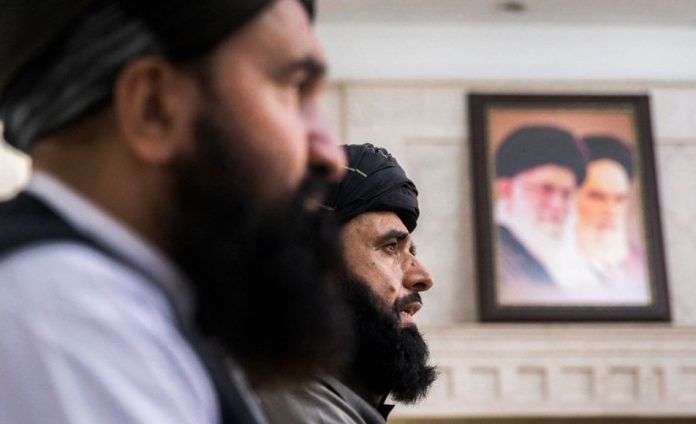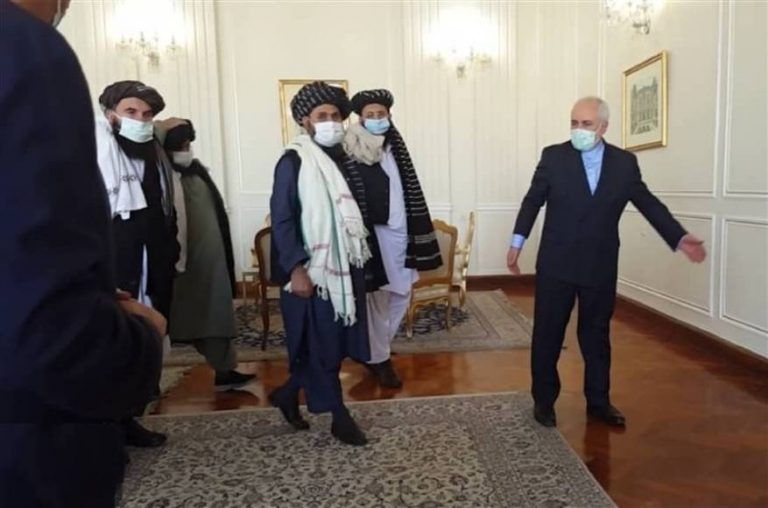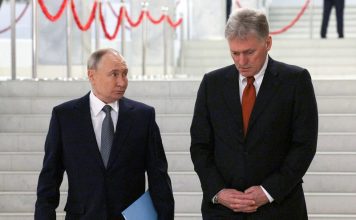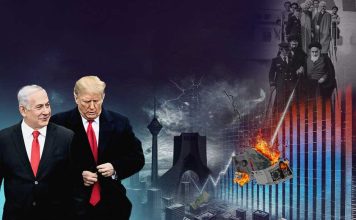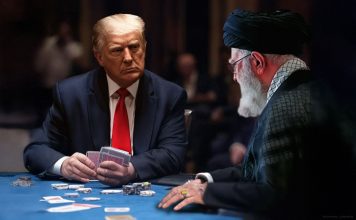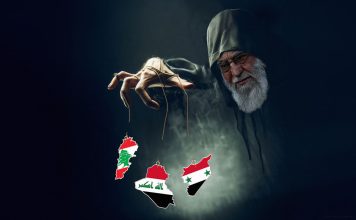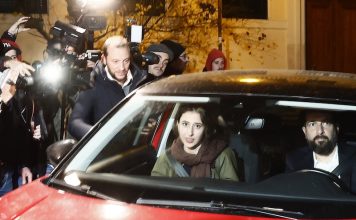Although the deep rift between Shias and Sunnis is the source of longstanding sectarian conflict in the Middle East, their mutual hatred of the U.S. prompts them to join forces sometimes. If Iran and the Shia militias operating under its auspices are a gang of brothers, then Iran and the armed Sunni groups sharing the same goals are stepbrothers.
On Aug. 8, 1998, Taliban forces attacked the Iranian Consulate General in the Afghan city of Mazar-e Sharif, killing 11 people, including a reporter, Mohammad Saremi, who worked for the Islamic Republic News Agency (IRNA). Subsequently, Aug. 8 was designated as “National Journalist Day” in Iran.
Iran’s Consul General Allahmadad Shahsoon was the only person who survived the attack. In an interview with the Mashhad-based Quds Online news agency the next day, he said: “I went to work early morning that day. Mr. Mohaghegh informed me that the Taliban had entered Mazar-e Sharif. We knew the city would fall to them soon. I told all my colleagues to get ready for what could happen next.”
“We held a meeting to decide how to interact with the Taliban if they entered the building. Our more experienced colleagues, with longer service records, believed that the Taliban forces would only hold them and prevent them from leaving the building,” Shahsoon explained. “[after the Taliban forces entered the consulate building], I offered some fruits to one of them, given I spoke some Pashtun. They rejected my offer abruptly. Their reaction concerned martyr Naseri.”
Some human rights groups alleged that in August 1998, Taliban forces killed some 2,000 people, mostly civilian members of the Hazara Persian-speaking minority in Mazar-e Sharif.
Since the attack 22 years ago, Iran has tried to establish a relationship with the Taliban. And despite repeated denials, Tehran has intensified its efforts to improve ties with the Taliban in recent weeks.
Since the mid-2000s, there have been many reports about the Islamic Revolutionary Guards Corps (IRGC) working with the Taliban.
In May 2010, the then commander of NATO and U.S. forces in Afghanistan, General Stanley McChrystal, said Iran was supplying the Taliban with weapons.
“There is, however, clear evidence of Iranian activity — sometimes providing weaponry and training to the Taliban — that is inappropriate,” NBC News quoted general McChrystal as saying.
In January, Iranian Foreign Minister Mohammad Javad Zarif chaired a meeting in Tehran with senior Taliban officials, led by its political leader Abdul Ghani Baradar. The meeting took place shortly after a report by the U.S. State Department alleged that the Taliban and Al-Qaida had created joint militias to target American interests in the region.
Iranian officials have sought to defend the decision by Iran to enter talks with the Taliban.
Speaking to the Tehran-based English-Language Tehran Times online newspaper on Jan. 21, Ahmad Naderi, a Majlis (Iranian Parliament) representing Tehran, Ray, Shemiranat, and Pardis, said: “The first generation of the Taliban displayed brutality and violence and committed massacres against many Afghans, especially Shias.”
“Certainly, the Taliban, like many other movements, have changed, and the new generation of the movement differs from the previous generation,” Mr. Naderi noted. “Our relationship with the Taliban is based on the principle of ‘the enemy of my enemy is my friend.’ We and the Taliban have a common enemy, and that is the United States.”
Following a meeting with the Taliban delegation on Jan. 27, the Secretary of the Supreme National Security Council of Iran, Rear Admiral Upper Half Ali Shamkhani, tweeted: “In the meeting with Taliban political delegation earlier today, we understood that the organization’s leadership is resolved in its efforts to fight America. A person who was imprisoned at Guantanamo Bay for 13 years has not abandoned the fight in the region.”
Secretary Shamkhani was referring to Abdul Haq Wasiq, who was released from the Guantanamo Bay detention center in 2014. He was a member of the Taliban delegation team that visited Tehran for talks in January.
In comments reported by the Iranian media on Sept. 3, 2014, Iran’s Supreme Leader Ayatollah Ali Khamenei, said: “They [Arab forces and their regional proxies] admit creating [Al-Qaeda and ISIS]. We have proof, even if they don’t admit it. We know.”
“We believe that all Afghan groups should decide Afghanistan’s future,” Foreign Minister Mohammad Javad Zarif said in an interview with Afghan Tolo TV. “Before killing anyone else, the Taliban killed eight of my colleagues. Therefore, the Taliban has carried out many terrorist acts.”
“The Taliban is a group inside Afghanistan that has carried terrorist acts. It must play a role in the future of Afghanistan, but cannot embrace the entire solution to Afghanistan’s future.” Mr. Zarif explained. “There is a massive difference between these two points.”
“We have not removed the Taliban from our list of terrorist organizations,” Zarif noted. “It is designated a terrorist organization by the UN, and we abide by the UN law.”
Although Iran has designated the Taliban as a terrorist group, the former commander of the IRGC’s Qods Force (IRGC-QF), the late Lieutenant General Ghasem Soleimani, welcomed the Taliban’s anti-U.S. policy. General Soleimani was killed in a U.S. drone attack on Baghdad International Airport on Jan. 3, 2020.
It is striking that Iran should roll out the red carpet for a visit by a recent Taliban delegation despite past hostilities. It is unclear what Tehran hopes to gain from this sudden turn in its foreign policy.
According to Western intelligence sources, the Taliban and Al-Qaida have strengthened their ties with each other and with Tehran. Senior Taliban and Al-Qaida leaders allegedly live in Iran.
Speaking to the National Press Club on Jan. 12, former U.S. Secretary of State Mike Pompeo said: “Unlike in Afghanistan, when Al-Qaeda was hiding in the mountains, Al-Qaeda today is operating under the hard shell of the Iranian regime’s protection.”
“Iran has allowed al-Qaeda to fundraise, to communicate freely with all kinds of members around the world, and to perform many other functions that were previously directed from Afghanistan or Pakistan,” Mr. Pompeo added. Iran served as “a new operational headquarters, on the condition that Al Qaeda operatives inside abide by the regime’s rules governing Al Qaeda’s stay inside the country.”
In a tweet a few hours later, the U.S. Department offered rewards for the information leading to the capture of an Al-Qaida member allegedly living in Iran.
The tweet said: “REWARD! Up to $7 Million for Information ‘Abd al-Rahman al-Maghrebi. Al-Maghrebi is an Iran-based key leader of the al-Qaida terrorist. If you have information on his location or identification, you could be eligible for a reward. Text your info to Rewards for Justice (RFJ).”
Later that day, Iranian Foreign Minister Mohammad Javad Zarif tweeted in English: “From designating Cuba to fictitious Iran ‘declassifications’ and AQ claims, Mr. ‘we lie, cheat, steal’ is pathetically ending his disastrous career with more warmongering lies.”
U.S. officials in the current and previous administration believe that Iran is the leading state sponsor of terrorism worldwide. Former President Donald Trump’s government designated the IRGC as a foreign terrorist organization in April 2019. The new U.S. President Joe Biden, who is committed to rejoining the Joint Comprehensive Plan of Action (JCPOA), better known as the Iran nuclear deal, has continued to keep the IRGC on the list of terrorist organizations.
President Biden’s Secretary of State Antony Blinken and Treasury Secretary Janet Yellen both believe that the IRGC is the leading sponsor of global terrorism. Both Trump and Biden administrations have either failed to realize or deliberately hidden the fact that while the IRGC and Shia militia groups under its control can carry out terrorist attacks against the U.S. and its allies, such operations would have dire consequences for Iran.
Most Shia armed organizations and groups, including the IRGC, Lebanese Hezbollah, and the Iraqi Popular Mobilization Forces (PMF), have a massive influence on their respective countries’ governments and risk severe political consequences if they take part in any terrorist operations directly. Therefore, they do not cross certain red lines. They use their proxy militias to carry out such operations.
The PMF is an Iraqi state-sponsored umbrella organization comprising some 40 militias that are mostly Shia Muslim groups and include Sunni Muslim, Christian, and Yazidi groups.
[aesop_image img=”https://kayhanlife.com/wp-content/uploads/2019/12/2019-08-04T132850Z_39638767_RC1F11CB9800_RTRMADP_3_IRAQ-MILITIAS-scaled.jpg” panorama=”off” credit=”FILE PHOTO: A member of the paramilitary Popular Mobilisation Forces (PMF) holds a weapon as part of a military training at their camp in Basra, Iraq. REUTERS/Essam al-Sudani” align=”center” lightbox=”on” captionsrc=”custom” captionposition=”left” revealfx=”off” overlay_revealfx=”off”]
Although weakened in the past decade, Al-Qaeda has maintained its regional and global network. It has even strengthened its presence in some countries, including Yemen, Afghanistan, and Pakistan.
Experience has shown that while Mr. Khamenei and the IRGC might renegotiate the nuclear deal, they consider Iran’s ballistic missile program and support for regional militia groups not open for discussion.
Iran’s goal is to release itself from the crippling grips of economic sanctions without abandoning its ballistic missile program and support for Shia militias and maintaining its ability to threaten the U.S., its allies, and their interests in the region. Experience has taught Khamenei and the ruling elite in Iran that U.S. Democrats are more focused on defeating Al-Qaeda and Taliban than Shia militias.
Former U.S. President Barack Obama and his then-Vice President Joe Biden’s regional policy revolved around crushing Al-Qaeda and Taliban. Donald Trump’s administration concentrated its efforts on neutralizing Shia groups, including the IRGC. For that reason, Trump placed Iran’s IRGC, the Houthi Movement in Yemen, and Iraqi PMF, and Asa’ib Ahl al-Haq on its list of terrorist organizations. As a result, Ghasem Soleimani and Mohsen Fakhrizadeh met the same fate as Osama Bin Laden, the founder of Al-Qaeda, who was killed by the U.S. special forces at his hideout in Abbottabad, Pakistan, on May 2, 2011.
On Nov. 27, Mohsen Fakhrizadeh, dubbed the “father of Iran’s nuclear program,” was killed by unknown attackers who reportedly used a “remote control weapon” to fire on his car in Mostafa Khomeini Boulevard in Absard, 80 kilometers east of Tehran.
Mr. Fakhrizadeh was an academic physicist and a faculty member at the Imam Hossein University in Tehran, and the founder of the Organization of Defense Innovation and Research. He was also a member of the Islamic Revolutionary Guards Corps (IRGC) with Brigadier General’s rank.
President Biden and Most Democrats would like to engage Shia militia groups in talks. One of Mr. Biden’s first act of foreign policy was to remove Houthis from the U.S. list of terrorist organizations. He also announced that his administration planned to re-evaluate the peace deal with the Taliban reached in February 2020.
Biden’s approach to Afghanistan seems to be the continuation of the Obama administration’s regional foreign policy. Biden’s administration is seeking the cooperation of Congress to delay Trump’s decision to withdraw U.S. military forces from that country.
Meanwhile, the Taliban know they will experience more significant political and military pressure with Biden in the White House, and, therefore, their best option after Al-Qaeda, is to establish closer ties with the IRGC.
According to U.S. intelligence sources, Al-Qaida has received most of its funding from Saudi Arabia in recent years. Several European leaders, including French President Emmanuel Macron, have suggested that Saudi Arabia should be part of any new nuclear negotiations, which means Riyadh must stop its support for Al-Qaida and work more closely with international institutions to fight global terrorism.
In his book titled “Intelligence Matters,” published in 2008, the former U.S. Democratic Senator Bob Graham provides a wealth of information based on reports and documents from CIA and the FBI on close ties between senior Saudi officials and the ruling family with Osama Ben Laden and his close associates regarding the creation of Al-Qaeda.
In an interview with Etemad online newspaper on Jan. 23, Foreign Minister Zarif said: “A foreign minister has two responsibilities: analyzing situations and presenting the facts in their entirety to the country. If the [Iranian] foreign ministry’s documents are ever published, they will show that I have never censored myself.”
“The other duty of a foreign minister is to defend the country’s official policies,” Zarif noted. “One implements state’s policies. One might have played a minor role in setting a policy. While I played a more significant role in drafting the JCPOA, I had a much-limited impact on setting regional policies. I also took a major part in developing Iran’s relationship with Russia, China, and Latin America.”
“I played a less significant role in setting Iran’s regional policies,” Zarif added. “My job was to implement these policies and defend the Islamic Republic’s actions. Sometimes, I did not approve of certain policies. I am not referring to any of the regional policies. Some policies threw obstacles in my path. When I am on the world stage, I represent the state’s policy in its entirety. I might have to defend things I do not believe in or am critical of, but I also know that people who oppose those policies do not have Iran’s best interests at heart.”
Mr. Zarif’s remarks show that the Islamic Republic regime’s policies do not always aim to protect the Iranian people’s interests. Maybe Khamenei had given his blessing to and even urged the recent meeting with the Taliban delegation.
Taliban and Al-Qaeda have a greater capacity to carry out terrorist acts on a global scale than Shia militias and Hezbollah operating under the auspices of the IRGC. Al-Qaeda and the Taliban will be empowered and emboldened through their cooperation with Iran. It will also transform Tehran into the headquarter for global terrorism and a bridge between Sunni and Shia armed militias.
Recent pressure on the Lebanese Hezbollah by the West, particularly France, and repeated pounding of the group’s military bases by the Israeli air force have weakened Hassan Nasrallah, the Secretary-General of the organization. He and his associations are now isolated and have limited their public appearances.
Several groups under Hezbollah’s umbrella have broken away in recent years, forming different political parties and paramilitary forces. Sheikh Subhi al-Tufayli, a Shia Islamist and the former First Secretary-General of Hezbollah, is now a staunch critic of the Islamic Republic. Mr. al-Tufayli is now a supporter of the Amal Movement (Hope Movement). The Free Shia Movement, led by Sheikh Mohammad Al Haji Hassan, is another Lebanese Shia political movement that opposes Hezbollah. It is affiliated with the March 14 Alliance, named after the Cedar Revolution’s date.
The Cedar Revolution (or Independent Intifada) was the name given to a nationwide protest in Beirut and elsewhere sparked by the assassination of the former Lebanese Prime Minister Rafik Hariri in February 2005. The March 14 Alliance comprises Shia, Sunni, and Christian groups that oppose Hezbollah.
[contact-form][contact-field label=”Name” type=”name”][contact-field label=”Email” type=”email”][/contact-form]
Joining forces with the Taliban and Al-Qaeda is a vital tactical move by Iran, given the unclear fate of the JCPOA. If Tehran is forced to abandon its support for Shia militia groups to revive the nuclear negotiation, it could then use the Taliban and Al-Qaida to further its regional goals. Also, the Taliban and Al-Qaeda have more experience carrying out terrorist operations against the U.S. than Hezbollah and the PMF.
By strengthening its ties with the Taliban, Iran is sending a message to the Biden administration that it can mobilize armed non-Shia and Sunni militias against the U.S. and its interest in the region. Tehran is also signaling the U.S. and the West, which fear nuclear terrorism, that it is within its power to pass on that capability to the Taliban and Al-Qaeda.
In an editorial on Feb. 6, the Tehran-based hardline Kayhan newspaper said: “The two superpower China and Russia, lack the Islamic Republic’s unique ability to mobilize forces in the region. America’s principal aim is to destroy this capability.”
What Kayhan is alluding to is Tehran’s ability and willingness to carry out terrorist operations in the region.
Ultimately, if Iran is forced to abandon its support for the Shia militia groups in the region to revive the JCPOA, it will continue its ideological war against the U.S. by mobilizing the Taliban and Al-Qaida. If the nuclear negotiations never occur, Iran will include the Taliban and Al-Qaida in the so-called “Axis of Resistance” to escalate its proxy war against the U.S.
This article was translated and adapted from Persian by Fardine Hamidi

